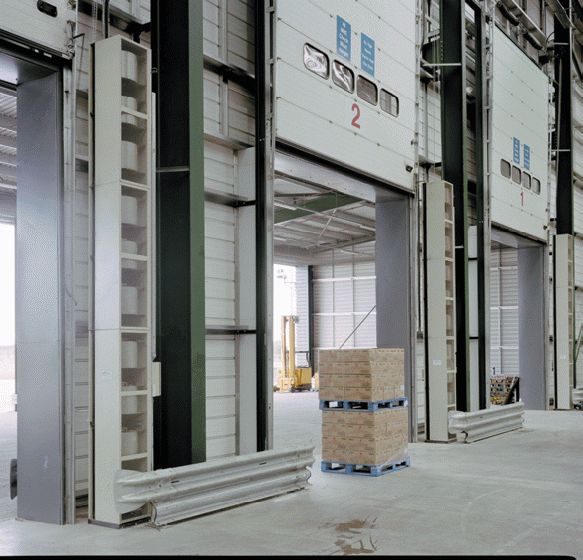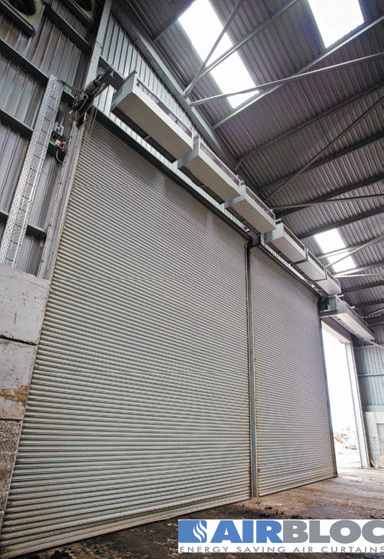 Within moments of opening a loading bay door, the temperature inside a warehouse can drop by up to 10°C. In today’s economic climate and with businesses looking to keep energy costs to an absolute minimum, air curtains can be a cost-effective, energy efficient solution
Within moments of opening a loading bay door, the temperature inside a warehouse can drop by up to 10°C. In today’s economic climate and with businesses looking to keep energy costs to an absolute minimum, air curtains can be a cost-effective, energy efficient solution
The opening and closing of external doorways is an unpreventable part of the job for warehouse operators. But every time this happens throughout the working day, warm air will escape and allow cold air to enter the building. The heating system must work harder and, over time, this makes a difference to fuel costs.
As well as the rising energy costs, opening and closing external doors will also affect the internal temperatures and reduce the comfort levels for employees – especially those working close to the doorway. And with many warehouses storing perishable items, temperature-sensitive stocks can also be compromised.
For the all-encompassing solution, without the inconvenience of constantly opening and closing doors – air curtains fit the bill perfectly.
 Comparative temperature readings show a drop of between 4°C and 10°C every time a warehouse door is opened. However, with an air curtain the difference is normally just 1°C. With an over door air curtain, energy lost through open doors which was previously seen as a unavoidable, can actually be reduced by as much as 80 per cent. Air curtains are so effective in separating internal and external environments that doorways can remain open all day with very little effect on the heating system’s energy consumption. Heated or unheated, depending on the warehouse’s requirements, they can even be configured to re-circulate warmed air within the building and add to the energy efficiency and economy of the unit.
Comparative temperature readings show a drop of between 4°C and 10°C every time a warehouse door is opened. However, with an air curtain the difference is normally just 1°C. With an over door air curtain, energy lost through open doors which was previously seen as a unavoidable, can actually be reduced by as much as 80 per cent. Air curtains are so effective in separating internal and external environments that doorways can remain open all day with very little effect on the heating system’s energy consumption. Heated or unheated, depending on the warehouse’s requirements, they can even be configured to re-circulate warmed air within the building and add to the energy efficiency and economy of the unit.
Curtain closes on heat loss
Energy efficient air curtains, such as those supplied by Airbloc, can be positioned directly over or down the side of a doorway. When doors are opened in heated buildings, colder external air flows in through the bottom part of the opening, while internal air flows out through the upper part. In air conditioned buildings, the opposite applies. Over door air curtains deliver a uniform flow of air across the full door width that separates the interior and exterior atmospheres.
 As well as their energy-saving capacity, the air curtains also have other benefits. Over door air curtains induce warm air down from high level that would otherwise be lost through the roof, thus helping to de-stratify the building and eliminate cold spots. Furthermore, when combined with an energy-saving control unit such as the SmartElec2 from Airbloc, both power consumption and energy costs can be reduced by up to 50 per cent. The unit offers a number of control options to suit all applications including thermostats linked to door closed sensors that turn units down or off to increase energy saving. Outside temperature sensors can also turn the elements off in warmer times, while timers will ensure the units only operate when required.
As well as their energy-saving capacity, the air curtains also have other benefits. Over door air curtains induce warm air down from high level that would otherwise be lost through the roof, thus helping to de-stratify the building and eliminate cold spots. Furthermore, when combined with an energy-saving control unit such as the SmartElec2 from Airbloc, both power consumption and energy costs can be reduced by up to 50 per cent. The unit offers a number of control options to suit all applications including thermostats linked to door closed sensors that turn units down or off to increase energy saving. Outside temperature sensors can also turn the elements off in warmer times, while timers will ensure the units only operate when required.
In addition, air curtains are not subject to the same wear and tear as roller-shutter doors so mechanical failures and damage can also become a thing of the past. So, for energy savings or not having to replace worn-out doors, air curtains can help contain overhead costs while preserving comfort for employees and maintaining ideal conditions for stock.
With air curtains doorways can remain open all day with little effect on the heating system’s energy consumption or the comfort of employees inside the building. They can in effect allow businesses to stop their profits from sneaking out the back door.
Airbloc
T: 0161 482 7900


